I'm calling a REST service from an Angular 9 app using HttpClient.get() and I'm not seeing a full list of the response headers. I know that the service is sending them because:
and
- when I hit the same REST service with a Java app it returns the full headers, about a dozen all together:
java.net.http.HttpHeaders@1627d314 { {access-control-allow-origin=[*], age=[0], connection=[keep-alive], content-length=[1207], content-type=[application/json], date=[Tue, 07 Jul 2020 05:11:45 GMT] <...etc>
What I get from the Angular HttpClient.get() is only one item in the header.keys():
headers: {
"normalizedNames": {},
"lazyUpdate": null,
"lazyInit": null,
"headers": {}
}
headerKeys:
[
"content-type: application/json"
]
I created a small sample app to demonstrate the problem. Here are the key components:
app.modules.ts:
import { BrowserModule } from '@angular/platform-browser';
import { NgModule } from '@angular/core';
import { HttpClientModule } from '@angular/common/http';
import { AppRoutingModule } from './app-routing.module';
import { AppComponent } from './app.component';
import { TesterComponent } from './tester/tester.component';
@NgModule({
declarations: [
AppComponent,
TesterComponent
],
imports: [
BrowserModule,
AppRoutingModule,
HttpClientModule
],
providers: [],
bootstrap: [AppComponent]
})
export class AppModule { }
tester.component.ts:
import { Component, OnInit } from '@angular/core';
import { HttpHeaders, HttpParams, HttpResponse, HttpClient } from '@angular/common/http';
import { Observable } from 'rxjs';
import { tap } from 'rxjs/operators';
@Component({
selector: 'app-tester',
templateUrl: './tester.component.html',
styleUrls: ['./tester.component.css']
})
export class TesterComponent implements OnInit {
_url: string = "https://api.nasa.gov/planetary/apod";
_api_key: string="DEMO_KEY";
//
_title: string;
_date: string;
constructor(private _httpClient: HttpClient) { }
ngOnInit(): void {
this.GetData(this._url).subscribe(() =>
{
// do other stuff
});
}
sendGetRequest(getUrl: string, headers: HttpHeaders, urlParams: HttpParams) : Observable<HttpResponse<Object>>{
return this._httpClient.get<HttpResponse<Object>>(getUrl, {headers: headers, params: urlParams, observe: 'response'});
}
GetData(url: string)
{
const params = new HttpParams()
.set("api_key", this._api_key);
return this.sendGetRequest(url, headers, params).pipe(
tap( response =>
{
console.log("returning data");
if (response.headers)
{
console.log('headers', response.headers);
}
const keys = response.headers.keys();
if (keys)
{
const headerKeys = keys.map(key =>
`${key}: ${response.headers.get(key)}`);
console.log('headerKeys', headerKeys);
}
this._date = response.body['date'];
this._title = response.body['title'];
},
err => {
console.log(err);
}
));
}
}
Addendum: To further illustrate the problem here is a small Java 11 program that calls exactly the same REST API with the same credentials. You can see from the output that the REST API is sending back all of the header response information. The question remains, why can't the Angular program calling exactly the same REST API see the full response headers? Is there some setting/flag/voodoo missing from the call?
Java 11 app:
import java.net.URI;
import java.net.http.HttpClient;
import java.net.http.HttpRequest;
import java.net.http.HttpResponse;
import java.net.http.HttpResponse.BodyHandlers;
public class MainClass {
public static void main(String[] args) {
String api_key = "DEMO_KEY";
String uri = "https://api.nasa.gov/planetary/apod";
uri += "?api_key=" + api_key;
HttpClient client = HttpClient.newHttpClient();
HttpRequest request = HttpRequest.newBuilder().uri(URI.create(uri)).build();
HttpResponse<String> response = null;
try {
response = client.send(request, BodyHandlers.ofString());
} catch (Exception e) {
e.printStackTrace();
}
System.out.println("------------------");
System.out.println("response.headers: " + response.headers());
System.out.println(response.body());
System.out.println("------------------");
}
}
Output from Java app (response.header only for brevity):
response.headers: java.net.http.HttpHeaders@96f4f3fc { {access-control-allow-origin=[*], age=[0], connection=[keep-alive], content-length=[1302], content-type=[application/json], date=[Wed, 08 Jul 2020 17:13:42 GMT], server=[openresty], strict-transport-security=[max-age=31536000; preload], vary=[Accept-Encoding], via=[http/1.1 api-umbrella (ApacheTrafficServer [cMsSf ])], x-cache=[MISS], x-ratelimit-limit=[40], x-ratelimit-remaining=[39]} }
Thanks for your help!
